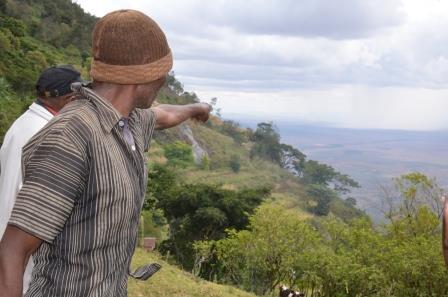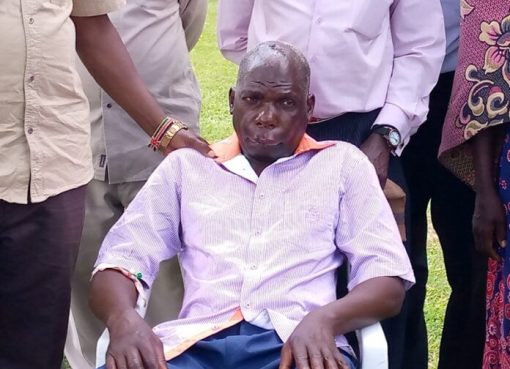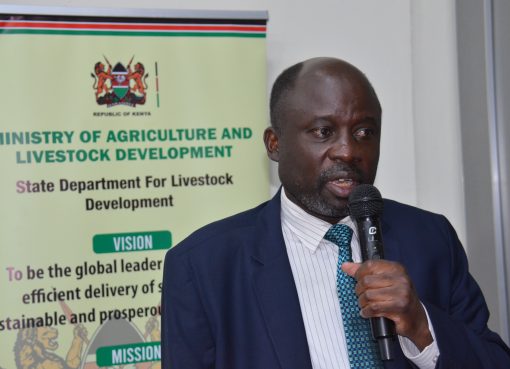At the far end of his one-acre farm at the foot of Taita Hills in Taita-Taveta County, Mzee Augustine Mwakisha, bends over a long row of germinating seedlings. His hands, gnarled from years of cultivating, feels the underside of the tender leaves for signs of pests. He finds none. Satisfied, he trudges to a raised portion of earth where more fruit seedlings are sprouting. He caresses their stems.

He then looks up with a delighted smile. “These are doing well. Within a few more weeks, they will be ready for transplanting,” he said.
Mzee Mwakisha, 62, is one of the 1,200 small-scale farmers from over ten villages around the iconic Taita Hills who have embarked on an ambitious project to rehabilitate vast swathes of degraded forest to preserve the vital ecosystem of the hills. Dubbed as Vuria Forest Reforestation and Livelihood Improvement (VUFORELI), the project brings together several community groups whose aim is to restore the degraded forests to their original status.
Located 200-km Northwest of Mombasa City at the Kenyan Coast, Taita Hills is one of Kenya’s water towers and a biodiversity hotspot. The hills are part of a complex ecosystem network made up of several forests including Vuria, Mshomoto, Mbololo, Fururu, Ngangao and Chawia amongst others.
The densely-forested hills are source of vital streams including the 210-km long Voi River which feeds into Aruba Dam in Tsavo East National Park for use by wildlife. These hills also are home to several small mammals, insects and rare bird species.
However, years of illegal logging and unchecked bush clearance has resulted to severe degradation of the Taita Hills. The forest cover has dwindled and rivers have dried up.
Alarmed by this wanton destruction, community members with farms bordering the hills formed groups that advocate for replanting of both indigenous and fruit trees in all degraded areas. As an additional requirement, individual group members have their own tree nurseries and are expected to plant trees in their farms to extend the forest cover from the hills to their farms.

“We want to have the whole area under forests as it used to be before the degradation happened,” notes the old farmer.
While the overall goal of reforestation is to increase Kenya’s forest from the current 7.4 per cent to 10 per cent by 2022, conservationists say the restoration of Taita Hills’ forests will serve an arguably more noble goal of giving a fragile lifeline to the survival of two of the most critically endangered bird species in the world
Taita Thrush and Taita Apalis, endemic to Taita Hills, feature prominently on the Red List of Critically Endangered Birds by International Union for Conservation of Nature (IUCN). Critically endangered category is the final stage before a species is officially declared extinct.
In a survey in August 2018, IUCN established that global population of Taita Apalis was between 210 and 430 birds. In 2016, IUCN had reported the population of Taita Thrush to be at 930. Several factors have been cited as contributing to this sharp decline of these birds’ species.
In Action Plan for Conservation of Critically Endangered Birds in Taita Hills- Kenya 2015-2020, a report by Kenya Wildlife Service and local conservation groups, factors including fragmented habitat, nest predation and reforestation using exotic trees were cited as key contributors to disappearance of these birds.
The Report indicate the population of Taita Thrush is at 1,400, a figure slightly higher than the one by IUCN. The birds were scattered in fragmented forests with Mbololo having a population of 1,060, Ngangao with 250 and Chawia was home to 35 birds.
The report further shows that the numbers of Taita Apalis lay between 300 and 500. Rare sighting of the birds were reported at Iyale, Msidunyi and Ngangao forests. Already, Apalis has totally disappeared from traditional habitats of Chawia and Fururu forests underscoring the profoundly grave danger facing the species.
Mr. John Mlamba, a conservation specialist, says the survival of the two species hangs by a thread. He adds human activities such as farming and shrinking habitat have all pushed the feathered beauties to the verge of extinction hence the needs for urgent intervention.
“Their natural habitats are all destroyed and they are struggling to survive. We are seeing the last of Apalis and Thrush in the world,” he noted.
In the 60s’, the two species flourished in tens of thousands. University of Helsinki, which had done extensive studies on the history of Taita Hills, says by 1960, forests of Taita Hills covered an area of 1,000 hectares. By then human population in the region was 90,000. That was then. In the last 50 years, the hills have lost over 60 per cent of the forest cover. Currently, the forest cover a paltry 400 hectares with human population having jumped to over 350,000.

Women from a village at the foot of Vuria Hill carrying firewood for domestic use from the forest.
Mr. Mlamba, who is also the Executive Director of Management of Arid Zones in Development Options (MAZIDO), an organization that deals with community-empowerment programs, says surging human population had near-catastrophic effect on Taita Hills.
Farmers cleared large tracks of forests as settlements cropped up between once unbroken habitats. The result was having fragmented forests with small population of birds permanently cut off from neighboring forests and trapped in shrinking forests.
“When the forest was unbroken continuum, the birds could fly for miles and miles to other areas. The situation is radically different. When forests were cut down, the birds were confined to singular forest habitat. They are prisoners in their habitats,” he explains.
This scenario has catalyzed inbreeding within small bird population with higher male ratio and ultimately leading to dwindling avian population.
Mr. Mlamba notes that with VUFORELI project, there is hope for the feathered beauties. The project envisages creation of ‘forest corridors’ in farms that will act as vital links scattered habitats. Once the farms are forested, the birds will move through these corridors to other forests without hindrance. He adds that the project is expected to add 1,000 acres of farm forests.
“The farmers are planting trees in their farms. The farm forests will be bridges to connect different habitats. The birds will be free to move,” he said.
Already, there are signs that reforestation efforts in Taita Hills are bearing fruits. Kenya Forest Service (KFS), the government agency responsible for protection of forests, says degradation has significantly reduced and the rehabilitated areas are showing signs of recovery.
Mr. Christopher Maina, the County Conservator, says KFS is urging farmers to plant bamboos and other indigenous trees in their farms which was contributing to increased tree cover. The region has a forest cover of 3.6 per cent. Once the project takes off, the forest cover is expected to go beyond five per cent.
“We are assisting farmers by donating seedlings. We have planted over 4,000 seedlings at Iyale Forest already,” he said.
To ensure sustainability, farmers are encouraged to practice agroforestry by planting fruit trees alongside the indigenous ones. These fruit trees include Avocado, Macadamia, Apricots and passion. Mr. Mlamba opines that if farmers can make money from the project through sale of fruits, more will join this conservation initiative. He terms VUFORELI as a broad-spectrum solution that will solve the degradation menace, offer livelihood to farmers and give the endangered birds a survival chance.
The project is however not without its challenges. Livestock keepers have been grazing in some rehabilitated areas destroying the seedlings. There is also the issues of villagers raiding the forests for firewood. To address this, the community groups are working closely with government officials to keep the livestock out of their farms and stop illegal firewood cutting.
“We are hopeful the project will succeed as the farmers have owned it,” he says.
Nevertheless, even as optimism remains that VUFORELI will change the fortunes of these birds, it will not be until 2023 after the maturation of the farm trees that the true effectiveness of the ‘bird corridors’ will be known.
By Wagema Mwangi





